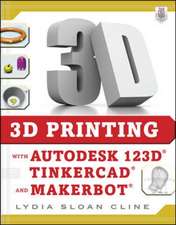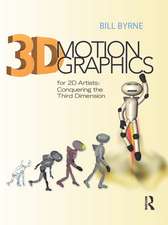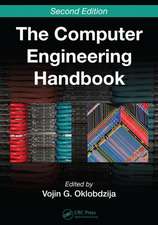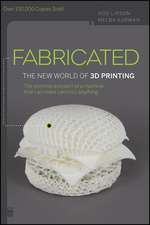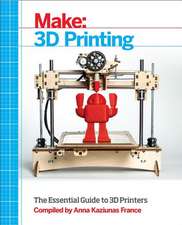Graphics Shaders: Theory and Practice, Second Edition
Autor Mike Bailey, Steve Cunninghamen Limba Engleză Hardback – 8 noi 2011
The book starts with a quick review of the graphics pipeline, emphasizing features that are rarely taught in introductory courses, but are immediately exposed in shader work. It then covers shader-specific theory for vertex, tessellation, geometry, and fragment shaders using the GLSL 4.x0 shading language. The text also introduces the freely available glman tool that enables you to develop, test, and tune shaders separately from the applications that will use them. The authors explore how shaders can be used to support a wide variety of applications and present examples of shaders in 3D geometry, scientific visualization, geometry morphing, algorithmic art, and more.
Features of the Second Edition:
- Written using the most recent specification releases (OpenGL 4.x and GLSL 4.x0) including code examples brought up-to-date with the current standard of the GLSL language.
- More examples and more exercises
- A chapter on tessellation shaders
- An expanded Serious Fun chapter with examples that illustrate using shaders to produce fun effects
- A discussion of how to handle the major changes occurring in the OpenGL standard, and some C++ classes to help you manage that transition
Preț: 612.96 lei
Preț vechi: 673.58 lei
-9% Nou
Puncte Express: 919
Preț estimativ în valută:
117.29€ • 122.46$ • 97.07£
117.29€ • 122.46$ • 97.07£
Carte tipărită la comandă
Livrare economică 04-18 aprilie
Preluare comenzi: 021 569.72.76
Specificații
ISBN-13: 9781568814346
ISBN-10: 1568814348
Pagini: 520
Ilustrații: illustrations
Dimensiuni: 235 x 191 x 25 mm
Greutate: 1.2 kg
Ediția:Revizuită
Editura: CRC Press
Colecția A K Peters/CRC Press
ISBN-10: 1568814348
Pagini: 520
Ilustrații: illustrations
Dimensiuni: 235 x 191 x 25 mm
Greutate: 1.2 kg
Ediția:Revizuită
Editura: CRC Press
Colecția A K Peters/CRC Press
Public țintă
Academic and Professional Practice & DevelopmentCuprins
The Fixed-Function Graphics Pipeline. OpenGL Shader Evolution. Fundamental Shader Concepts. Using glman. The GLSL Shader Language. Lighting. Vertex Shaders. Fragment Shaders and Surface Appearance. Surface Textures in the Fragment Shader. Noise. Image Manipulation with Shaders. Geometry Shader Concepts and Examples. Tessellation Shaders. The GLSL API. Using Shaders for Scientific Visualization. Serious Fun. Appendices. References. Index.
Recenzii
"If you are one of the multitudes of OpenGL programmers wondering about how to get started with programmable shaders or what they are good for, this is the book for you. Mike and Steve have filled their new edition with such a variety of interesting examples that you'll be running to your computer to begin writing your own shaders."
—Ed Angel, Chair, Board of Directors, Santa Fe Complex, Founding Director, Art, Research, Technology and Science Laboratory (ARTS Lab), Professor Emeritus of Computer Science, University of New Mexico
"Shaders are an essential tool in today’s computer graphics, from films and games to science and industry. In this excellent book, Bailey and Cunningham not only clearly explain the how and why of shaders, but they provide a wealth of cutting-edge shaders and development tools. If you want to learn about shaders, this is the place to start!"
—Andrew Glassner
Praise for the First Edition:
"Bailey and Cunningham provide a comprehensive, well-written overview of graphics shaders. … Although the book uses the OpenGL Shading Language (GLSL) for its examples, it gives enough theoretical background for readers to learn the fundamentals for any graphics language. … The book also addresses scientific visualization and the GLSL API to call GLSL functions from an OpenGL program. A final chapter offers ideas for using shaders in very entertaining ways. … Highly recommended."
—C. Tappert, CHOICE, December 2009
"… a pick for any college-level, advanced computer library catering to programming professionals. … discusses different types of shaders, how to use the glman program for free, and how to blend shaders into an interactive game environment. Libraries will find it a powerful, appealing lend for intermediate programmers seeking extra spice for their projects."
—Midwest Book Review, August 2009
—Ed Angel, Chair, Board of Directors, Santa Fe Complex, Founding Director, Art, Research, Technology and Science Laboratory (ARTS Lab), Professor Emeritus of Computer Science, University of New Mexico
"Shaders are an essential tool in today’s computer graphics, from films and games to science and industry. In this excellent book, Bailey and Cunningham not only clearly explain the how and why of shaders, but they provide a wealth of cutting-edge shaders and development tools. If you want to learn about shaders, this is the place to start!"
—Andrew Glassner
Praise for the First Edition:
"Bailey and Cunningham provide a comprehensive, well-written overview of graphics shaders. … Although the book uses the OpenGL Shading Language (GLSL) for its examples, it gives enough theoretical background for readers to learn the fundamentals for any graphics language. … The book also addresses scientific visualization and the GLSL API to call GLSL functions from an OpenGL program. A final chapter offers ideas for using shaders in very entertaining ways. … Highly recommended."
—C. Tappert, CHOICE, December 2009
"… a pick for any college-level, advanced computer library catering to programming professionals. … discusses different types of shaders, how to use the glman program for free, and how to blend shaders into an interactive game environment. Libraries will find it a powerful, appealing lend for intermediate programmers seeking extra spice for their projects."
—Midwest Book Review, August 2009
Notă biografică
Mike Bailey is a professor of computer science at Oregon State University. Dr. Bailey is a member of ACM, SIGGRAPH, IEEE, ASME. He earned a Ph.D. in computer graphics and computer aided design from Purdue University. His areas of interest include scientific visualization, high performance computer graphics, GPU programming, solid freeform fabrication, geometric modeling, and computer aided design and analysis.
Steve Cunningham is a professor emeritus of computer science at California State University Stanislaus. A member of ACM SIGGRAPH, ACM SIGCSE, and Eurographics, he has been actively engaged in computer graphics education for many years.
Steve Cunningham is a professor emeritus of computer science at California State University Stanislaus. A member of ACM SIGGRAPH, ACM SIGCSE, and Eurographics, he has been actively engaged in computer graphics education for many years.
Descriere
Highly recommended by CHOICE (December 2009), the first edition of Graphics Shaders: Theory and Practice has proven to be a popular choice for shaders courses at universities and conferences. Incorporating changes in the OpenGL syntax, this second edition provides an engaging and accessible introduction to the latest developments in graphics shaders. The authors thoroughly explain the concepts, use sample code to describe details of the concepts, and then challenge readers to extend the examples. Sample source code for many of the book’s examples is available on a companion website.

